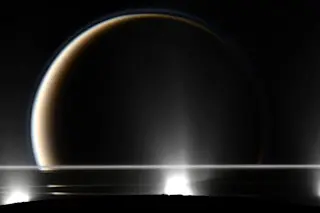Among Saturn’s substantial posse of moons—61 have been discovered so far—two particularly odd ones are capturing the imagination of planetary scientists. A torrent of findings has shown that giant Titan (3,200 miles wide, larger than the planet Mercury) and tiny Enceladus (just one-tenth as big) are worlds of unexpected complexity, placing them among the most promising extraterrestrial sites in our solar system to look for prebiotic chemistry or even for life itself. Research in the past several months has further fueled the excitement, yielding new hints of liquid water on Enceladus and revealing ethane lakes and methane rain on Titan.
In 2005, while exploring the Saturn system, the Cassini spacecraft made a startling discovery: Cryovolcanoes on Enceladus were spewing jets of water vapor and ice into space, possibly from a liquid water source beneath the surface. This past July researchers examining data from Cassini’s mass spectrometer announced that the icy ...















